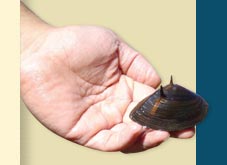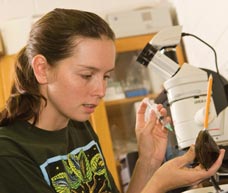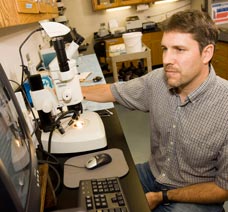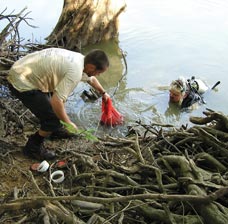To Save a Mussel, Find Its Fish
A joint UGA/DNR project aims to rescue the
imperiled Altamaha spinymussel by identifying the fish it depends on for procreation
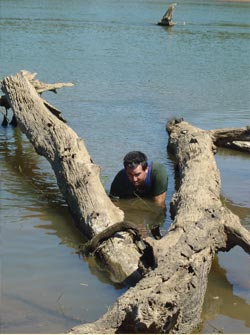
It’s a chilly day in October and Jimmy Rickard is steering an aluminum fishing boat past gray logs and stretches of tan bottom that rise fast in the drought-reduced Altamaha River. “This segment right here is where we’ve found more spinymussels than anywhere else,” says the U.S. Fish and Wildlife Service biologist.
How many? “Twenty to 25,” Rickard answers flatly. By contrast, old-timers tell of a time when they had to wear shoes in the river to keep from getting “stung” by the vast numbers of these prickly critters.
The Altamaha spinymussel (Elliptio spinosa) may be one of the more charismatic freshwater mussels, with its short spikes, or “spines,” drawing easy comparisons to punk hairdos, dinosaur backs, and even deer antlers. Yet charisma hasn’t kept Altamaha spinies, as these mussels are affectionately called, from joining the estimated 70 percent of U.S. freshwater mussels gone or going extinct.
Last year,
researchers at the University of Georgia and the state Department of Natural
Resources (DNR) teamed up to tackle a big unknown involving the Altamaha
spinymussel: the host fish it depends on for procreation. The majority
of freshwater mussels need fish for this purpose because they attach their
larvae to fish gills; different species of mussels latch onto different
fish. Once the larvae develop into juvenile spinies, called glochidia,
they drop off to continue maturing.
Results from the two-year State Wildlife Grant project, intended to gather details on other mussels endemic to the Altamaha basin as well, will factor into recovery plans and, possibly, fisheries management on the massive river system. For example, the spinymussel could depend on a fish that has declined on the Altamaha, such as Atlantic sturgeon or striped bass, said DNR wildlife biologist Jason Wisniewski.
The research comes none too soon for the Altamaha spinymussel, suggests UGA assistant professor of fisheries Robert Bringolf, who co-directs the project with Wisniewski. “We’re at a critical point right now,” said Bringolf. ”If we don’t figure something out in terms of propagation, the spinymussel will probably disappear.”
Of mussels and fish
Thus Wisniewski and Bringolf believe that finding the spiny’s host fish, while beefing up science’s grasp of the basic biology of these species, is vital to conserving them both. The researchers’ work could well define the spinymussel’s reproductive season, for instance, and chart influences such as water temperature. The Georgia Wildlife Action Plan, a strategy guiding DNR conservation efforts, places a premium on conserving such high-priority animals and habitats.
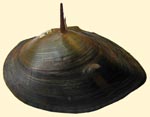
As feeders sucking in food such as algae and bacteria, mussels filter as much as six gallons of water a day, siphoning out pollutants and sediment that improve water clarity. Mussels can also be considered water quality’s canary in the coal mine; they are among the most sensitive of organisms to contaminants such as ammonia, which is commonly associated with municipal wastewater discharges, said Bringolf.
The process first involves diving for gravid (egg-bearing) spinymussels on the Altamaha, near Jesup, during the winter and spring of 2009. Researchers carry the retrieved mussels, or vials of their extracted glochidia, to the fisheries lab at UGA’s Warnell School of Forestry and Natural Resources. There, the researchers stir the glochidia in buckets of water with native Altamaha fishes, starting with likely suspects such as stripers, sturgeon, and American shad.
Finally,
the exposed fish are placed in separate tanks in a bank of small aquariums.
Researchers monitor the water that circulates through the tanks for transformed
juvenile mussels, which usually show up in 12 to 30 days. The presence
of juvenile spinies in a specific tank will presumably identify the species’
host fish. A next step would be trying to culture or raise the young mussels,
a process already in full swing for many other mussel species.
Grubbing for mussels
Sounds good, but “it’s all going to come down to whether we can find gravid female spinymussels in sufficient numbers,” said Bringolf.
To increase that likelihood, heavy lifting for the study began in early October 2008 with what Wisniewski called a “spinymussel blitz.” As a researcher with DNR’s Nongame Conservation Section since 2004, he has sought spinymussels often enough to have acquired a feel for their favored habitats. He looks for subtle transitions in stream flow, such as from fast current to the start of an eddy, and places where the river bottom features a seam of hard-packed fine-grain sand.
In such locations, a small group of waterlogged researchers grubbed the river bottom during three days on the Altamaha and the lower Ocmulgee searching for spinymussels, which are prone to digging 2-to-4 inches down. The blitzers found just nine spinies after hours of wiggling through sloughs and shallows, their wrinkled hands probing like coons’ feet through sand and mud and under logs and limbs.
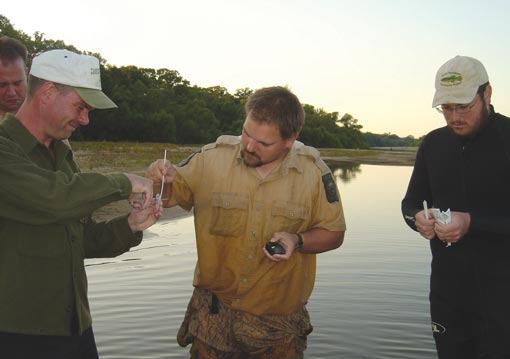
Biologists Jimmy Rickard (above left), of the U.S. Fish and Wildlife Service; Jason Wisniewski (center), of the Georgia Department of Natural Resources; and Paul Benton (right), of the Georgia Department of Transportation, collect DNA samples from the mussels for genetic analysis.
Musselspeak
Glochidia: The parasitic larval stage of freshwater mussels.
Host fish: Fish species that serve as a host for glochidia, which attach to the fish’s gills.
Conglutinate: A mucous-encased matrix of glochidia that mussels release in different ways to be eaten by host fish, which then become infected with the glochidia.
Juvenile: Mussels grown from the larval stage but not yet sexually mature or as large as adults.
Transformation: The changes that glochidia undergo while attached to a host fish.
Mantle: The soft tissue found near the edge of the mussels’ shell. The mantle also “grows” the shell by secreting material.
Mantle lure (or display): Mantle flaps used by some mussel species to mimic minnows and attract fish, which are then infected with glochidia when they try to eat the lure. Videos and photographs at www.unionid.missouristate.edu
Sources include U.S. Fish and Wildlife Service
The nine spinymussels were tagged, logged, and returned to sites that Wisniewski will check again this winter and spring. He hopes this take-and-put process will boost the odds of finding spinies. But research involving Altamaha basin mussels in 2005, done by Wisniewski and Jason Meador, a former UGA graduate student, estimated that the probability of locating spinies at a site where they’ve previously been present is only about 5 percent.
The drought that stretched through 2008 reduced water levels and generally made mussel hunting on the Altamaha easier, though it is not clear what impact the low flows have had on spinymussels in particular. Prolonged drought foils any mussel’s dig-deeper-when-it’s-dry response and opens new stretches of riverbed to ATVs and other vehicles that can grind up banks—and mussels.
Rickard believes, moreover, that spinies might be suffering “death by a thousand cuts”—not only through drought and its consequences but also invading species such as the flathead catfish and Asian clam, contaminants in municipal and industrial effluent, farm runoff, and increased sedimentation and turbidity from development, forestry, and mining.
Plus there’s the possible decline in Elliptio spinosa’s preferred fish.
Wisniewski’s hunch is that, along
with habitat changes, the host fish is the missing link. But with about
90 fish species in the Altamaha, “we don’t have a clue yet as to what the
host could be,” he acknowledged. Still, the researchers are systematically
developing clues, which could solve the mystery and ultimately help provide
more of a future for the Altamaha spinymussel.
(Rick Lavender is communications coordinator for the Nongame Conservation Section, Georgia Department of Natural Resources).
 |


